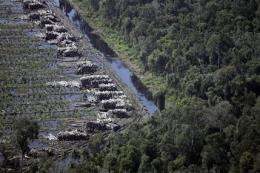FILE - In this Nov. 2, 2007 file photo, acacia logs are seen collected before being transported as the natural forest is seen at right in Pangkalan Kerinci, Riau province, on Sumatra island, Indonesia. Southeast Asia will be hit particularly hard by climate change, causing the region's agriculture-dependent economies to contract by as much as 6.7 percent annually by the end of the century, according to a study released Monday, April 27, 2009. (AP Photo/Dita Alangkara, FILE)
(AP) -- Southeast Asia will be hit particularly hard by climate change, causing the region's agriculture-dependent economies to contract by as much as 6.7 percent annually by the end of the century, according to a study released Monday.
The Asian Development Bank study focused on Indonesia, the Philippines, Thailand and Vietnam. Those countries are especially vulnerable because they have large coastal populations facing rising sea levels and rely heavily on rice and other agriculture products which could suffer from water shortages as well as floods. Vietnam was found to be the most vulnerable.
"Climate change seriously threatens Southeast Asia's families, food supplies and financial prosperity," said Ursula Schaefer-Preuss, the ADB's vice president for knowledge management and sustainable development. "If Southeast Asian nations delay action on climate change, their economies and people will ultimately suffer.'
If nothing is done to combat global warming, the report said that by 2100 the four Asian countries would see temperatures rise an average of 8.6 Fahrenheit (4.8 Celsius) from the 1990 level. They would also likely suffer drops in rainfall leading to worsening droughts and more forest fires, more destructive tropical storms and flooding from rising seas that could displace millions of people and lead to the destruction of 965 square miles (2,500 square kilometers) of mangroves.
The economic cost, according to the report, would be 2.2 percent of gross domestic product by 2100 if only the impact on markets is considered, 5.7 percent if health costs and biodiversity losses are factored in and 6.7 percent of gross domestic product if losses from climate-related disasters are also included.
That far exceeds the projected cost globally of climate change, estimated at 2.6 percent of gross domestic product each year by the end of the century.
Currently, governments are working to lay the groundwork ahead of a U.N. conference in December in Copenhagen that will attempt to draft a new agreement on regulating carbon emissions. It would replace the 1998 Kyoto Protocol which expires in 2012.
The ADB said Southeast Asian nations would have to do their part - even though their emissions were minuscule compared to China and the United States. But these countries should get billions of dollars in financial assistance from richer nations to help them address the problem and their efforts at mitigation should not come at the expense of slower development.
"Most politicians are only looking at this from an environment view but this is wrong," said Emil Salim, an environmental adviser to the Indonesian government who also contributed to the report. "You would be forgetting that we have unemployment and poverty."
The key for Southeast Asia would be protecting its remaining tropical forests which have fallen victim in recent years to widespread illegal logging and the expansion of palm oil plantations, the report found. Deforestation represents as much as 75 percent of the four country's emissions.
The report advised investing in tree planting programs, better forest management and programs that pay governments to keep trees in the ground.
It also recommended further measures to mitigate the impact of climate change, such as irrigation networks, flood control systems, early warning systems and protecting coastal mangroves.
It estimated such steps would cost $5 billion per year on average by 2020 but that benefits would exceed the cost after 2050. It said by 2100 that the benefits could be 1.9 percent of GDP compared to cost of taking action which would amount to 0.2 percent of GDP.
The report also found that 40 percent of energy-related carbon emissions could be reduced by 2020 if the countries invested in more energy efficient buildings, fuel efficient cars and public transport. Another 40 percent could be reduced by switching from coal to natural gas and renewable energy like solar and wind for power generation.
©2009 The Associated Press. All rights reserved. This material may not be published, broadcast, rewritten or redistributed.


















